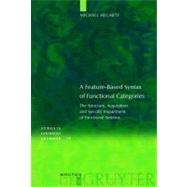
Note: Supplemental materials are not guaranteed with Rental or Used book purchases.
Purchase Benefits
What is included with this book?
| Chapter 1: Introduction | 1 | (13) | |||
|
1 | (3) | |||
|
4 | (4) | |||
|
8 | (6) | |||
| Chapter 2: A feature-based derivation of functional heads | 14 | (33) | |||
|
14 | (11) | |||
|
25 | (19) | |||
|
25 | (5) | |||
|
30 | (12) | |||
|
42 | (2) | |||
|
44 | (3) | |||
| Chapter 3: Germanic verb-second and expletive subjects | 47 | (55) | |||
|
48 | (19) | |||
|
67 | (11) | |||
|
78 | (19) | |||
|
78 | (5) | |||
|
83 | (8) | |||
|
91 | (1) | |||
|
92 | (5) | |||
|
97 | (5) | |||
| Chapter 4: Aspects of clitic placement and clitic climbing | 102 | (62) | |||
|
102 | (9) | |||
|
111 | (23) | |||
|
111 | (7) | |||
|
118 | (5) | |||
|
123 | (6) | |||
|
129 | (5) | |||
|
134 | (5) | |||
|
139 | (16) | |||
|
139 | (5) | |||
|
144 | (4) | |||
|
148 | (3) | |||
|
151 | (2) | |||
|
153 | (2) | |||
|
155 | (2) | |||
|
157 | (7) | |||
| Chapter 5: Tenseless clauses and coordination | 164 | (33) | |||
|
164 | (23) | |||
|
164 | (12) | |||
|
176 | (8) | |||
|
184 | (3) | |||
|
187 | (8) | |||
|
187 | (5) | |||
|
192 | (3) | |||
|
195 | (2) | |||
| Chapter 6: The acquisition of functional features | 197 | (16) | |||
|
197 | (2) | |||
|
199 | (2) | |||
|
199 | (2) | |||
|
201 | (1) | |||
|
201 | (8) | |||
|
201 | (5) | |||
|
206 | (2) | |||
|
208 | (1) | |||
|
209 | (3) | |||
|
212 | (1) | |||
| Chapter 7: The acquisition of adult functional categories | 213 | (67) | |||
|
216 | (12) | |||
|
216 | (2) | |||
|
218 | (1) | |||
|
219 | (2) | |||
|
221 | (3) | |||
|
224 | (2) | |||
|
226 | (2) | |||
|
228 | (10) | |||
|
228 | (5) | |||
|
233 | (2) | |||
|
235 | (2) | |||
|
237 | (1) | |||
|
238 | (13) | |||
|
238 | (5) | |||
|
243 | (3) | |||
|
246 | (3) | |||
|
249 | (2) | |||
|
251 | (9) | |||
|
251 | (4) | |||
|
255 | (5) | |||
|
260 | (5) | |||
|
261 | (2) | |||
|
263 | (1) | |||
|
264 | (1) | |||
|
265 | (4) | |||
|
265 | (2) | |||
|
267 | (2) | |||
|
269 | (8) | |||
|
269 | (5) | |||
|
274 | (3) | |||
|
277 | (3) | |||
| Chapter 8: The representation of functional categories as a factor in Specific Language Impairment | 280 | (32) | |||
|
282 | (7) | |||
|
283 | (1) | |||
|
284 | (1) | |||
|
285 | (1) | |||
|
286 | (1) | |||
|
287 | (2) | |||
|
289 | (3) | |||
|
292 | (11) | |||
|
292 | (9) | |||
|
301 | (2) | |||
|
303 | (7) | |||
|
310 | (1) | |||
|
311 | (1) | |||
| Chapter 9: Conclusion | 312 | (3) | |||
| Appendix | 315 | (6) | |||
| References | 321 | (20) | |||
| Index of names | 341 | (3) | |||
| Index of subjects | 344 |
The New copy of this book will include any supplemental materials advertised. Please check the title of the book to determine if it should include any access cards, study guides, lab manuals, CDs, etc.
The Used, Rental and eBook copies of this book are not guaranteed to include any supplemental materials. Typically, only the book itself is included. This is true even if the title states it includes any access cards, study guides, lab manuals, CDs, etc.